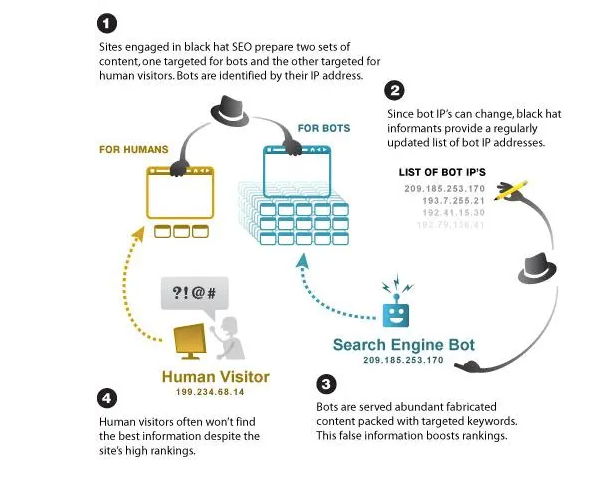What Is Cloaking In SEO | The Truth Revealed

Search engine optimization is a gradual process. You need to tick numerous boxes before expecting your website to rank high on the search engine results page (SERP). This process can take months. This article is going to focus on what is cloaking in SEO.
However, there is an alternative to this, that can fast-track your SEO goals.
Wondering what this is?
We are talking about the concept of cloaking in SEO, a black hat technique that web designers use for better indexing.
To understand this better, let’s dive into the details of this process.
Definition
Cloaking in SEO refers to a technique based on feeding different versions of the information to search engine users and crawlers than to its users. This, in turn, results in manipulating the search engine rankings by providing it with cloak content.
The primary objective of this technique, therefore, is to get a higher ranking for your web page on the SERP.
You need to understand that this is an illegal practice and is considered a black hat SEO practice. It comes with repercussions and penalties but more on that later.
How does cloaking work?
With the assistance of cloaking in SEO, you can get better results for your website and increase your prospects of getting more results. But, you must be wondering how does this gets implemented?
This section will answer your question.
Every device is assigned different IP addresses in the digital world. Cloaking in SEO uses these IP addresses and user agent HTTP header to deliver content to different users.
This is done by tampering with a file called .htaccess. You can use an apache server module called “mod_rewrite” on the .htaccess file to initiate cloaking on your web pages.
Now, the google webmaster gathers these IP addresses or search engine crawlers. The ‘mod_rewrite’ module detects whether the IP address belongs to search engine bots or not and delivers a different version of content based on the results. It provides an altered version (Cloak URL) of the web page to bots and an unaltered version to ordinary users.

Some common cloaking practices
Now that you know the basic functioning of the cloaking process. It is time to look at some of the common ways to implement this technique.
1. Flash pages and websites
Flash-based websites are not recommended as per the SEO guidelines. However, numerous websites require a lot of unavoidable flashes. Instead of rebuilding the entire website with plain HTML codes, individuals create content-rich web pages and provide them to bots on search engines and feed flash pages to human users.
2. E-mail cloaking
This is a practice of hiding the name and other credentials of the sender so that the recipient doesn’t get to know who sent the e-mail.
This is a common practice in companies that send bulk emails as it serves many purposes. One such reason is to prevent an individual from swamping the sender’s e-mail server with retribution spam.
3. Image gallery websites
Search engine crawlers do not scan images on a web page. Therefore, web designers seek to cloak using pictures as they help them get better rankings for relevant keywords.
4. HTML rich websites
SEO guidelines recommend having a good ‘text to HTML ratio.’ The higher the ratio, the better your chances of ranking well on the SERP. This means that your web page should have more text than HTML tags.
But, if you are putting out short articles, your text to HTML ratio is bound to be poor. Therefore, to avoid redesigning the entire website, web admins optimize it by using cloaking to meet SEO guidelines.
5. Invisible text
This method is used to add additional elements like keyword stuffing and overwritten content in a way that is invisible to users. A common way of doing this is adding the text in the same color as the web page’s background color, which is invisible to human eyes.
You’ve to admit, quite clever right?
Google’s webmaster guidelines and cloaking
Despite the specific benefits that cloaking in SEO brings, it goes against the Google webmaster’s guidelines. Therefore, it might not be the most viable technique for SEO optimization.
If you are using cloaking, you run the risk of getting your site re-indexed or removed from SERP’s index for a temporary boost in rankings. If Google detects such practices, it will penalize your website with bans and other repercussions.
About 10 years ago, cloaking in SEO would have been an excellent option for ranking higher in the SERP. But currently, due to advancements in search engines algorithm, it is challenging to get away with such practices without being traced.
According to Google, some examples of cloaking include;
- Providing search engines with an HTML text page while showing a page of images or Flash to users.
- The insertion of keywords into a web page only when search engine crawlers request it and not when done by a human user.
Affiliate URL cloaking
As discussed earlier, cloaking is done by tampering with the .htaccess files. However, another common way of implementing this technique is to use a third-party plugin. This is known as affiliate link cloaking.
It is the process of setting up a URL redirect to disguise the initial URL. It shortens the URL and makes it look more trustworthy and easier to track for search engine users.
Here’s an example to further elucidate the process:
Suppose that you have started a business that sells ice cream cones. Since you are still learning about the whole e-commerce world, hire a third-party vendor to help you sell and promote your product. While you market your ice cream cones on your website, you’ll need to provide your customer with a URL to allow them to purchase the product.
The link to your product might look something like this if you don’t use link cloaking:
https://www.etsy.com/listing/596553539/ice-cream-cones-chocolate-bag of 10?ga_order=most_relevant&ga_search_type=all&ga_view_type=gallery&ga_search_query=taco+sleeping+bag&ref=sr_gallery-1-19&from_market_listing_grid_organic=1&frs=1&cns=1https://www.amazon.com/dp/B07RPZZ867?linkCode=ogi&tag=goodhousekeeping_auto-append-20&ascsubtag=[artid|10055.g.28649116[src|[ch|[lt|
Not only does this look messy, but it also might make customers wary of where the link might lead them. With the help of URL rewriting by a link cloaking plugin, your link can look something like this.
www.icecreamcones.com/our-product
Neat, simple, and trustworthy since it has the domain name in it.
Benefits of using affiliate URL cloaking
Here are some of the prospective reasons that might tempt you to use affiliate link cloaking for your website:
1. Builds trust among users
With the help of affiliate link cloaking, you can create a link that appears trustworthy o your users. Instead of seeing a giant link with a series of strange characters and letters in it, you can provide your users with a link that contains your domain and product name.
2. Boosts SEO and click-through rates
Google and other search engines will rank your site lower if it has too many links guiding readers to other sites. Link cloaking helps you avoid that by maintaining a balance between internal and external links.
Moreover, it can also help improve your click-through rates. If the URL appears more trustworthy, users are more likely to click on it. This can very well be the difference between closing a deal and losing a customer.
3. Makes it easy to track outgoing traffic
Link cloaking plugins provide you with the option of seeing who is clicking your link and lets you check if the redirect URL is working or not. This can help you improve your marketing strategy.
Let’s go back to our ice cream cones example to understand this. Suppose you have two products: chocolate ice cream cones and vanilla ice cream cones. You are not sure as to which one will customers prefer more. Therefore, you’ll use URL cloaking to determine which product generates more traffic. Once this is done, you can feed your customers with that particular product’s link to generate more traffic.
Some common affiliate URL cloaking plugins
Now that you know how to link cloaking works for search engines, it is time to look at some of the most used plugins available in the market.
- Pretty Links
- Simply URLs
- Easy Affiliate Links
- EasyAzon
- URL Shortener PRO
- Woo Commerce CLoak Affiliate Links
- Amazon Auto Links
To sum up
Cloaking comes with its own set of upsides and downsides. On the one hand, it can help make your site look more reliable and informational to users and on the other hand, it violates the Google webmaster’s guidelines and can lead to penalties.
So, should you resort to cloaking to generate a higher ranking in the search engine results pages? Well, that is for you to decide. We advise you to keep the cloaking mechanism at the minimum level and rely on other white hat search engine optimization techniques to generate better results.
But you can surely, use link cloaking to make your product URLs look clean and trustworthy. But, make sure that you don’t go overboard with its usage and familiarize yourself with all webmaster’s guidelines regarding URL cloaking.
We hope that this article helped you answer the question of what is cloaking in SEO and provide you with some valuable insights.
